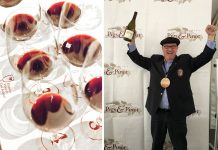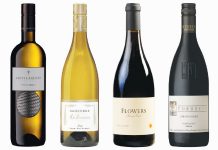By Charles Fredy
 When I teach restaurateurs about wine, we discuss why anyone would spend $500 on a bottle, when you can get a perfectly nice wine for $40. The answer? Superior quality—which is both difficult and costly to achieve.
When I teach restaurateurs about wine, we discuss why anyone would spend $500 on a bottle, when you can get a perfectly nice wine for $40. The answer? Superior quality—which is both difficult and costly to achieve.
Each vineyard is capable of producing only so much flavor. The more fruit on the vines, the more diluted the flavor. So wineries that choose to produce a truly exceptional vintage deliberately limit the amount of fruit their vines produce to between half a ton and three tons per acre. (The norm is five to eight tons or more.) Of course, nobody can stay in business producing half a ton—unless they charge a lot for their wine.
In many vineyards, restricted production happens naturally. Vines produce less as they age; and hilly terrain, poor soil, and other conditions can all inhibit growth. Vineyard managers can limit production by restricting the number of clusters or removing some of the grapes early (“dropping fruit”), so the energy of the vine goes into ripening what remains.
Surprisingly, another way to enhance quality is by making the vines struggle to survive. When a vine can obtain all the water and nutrients it needs at the surface, it develops a shallow root ball, pulling its flavor from perhaps three feet of soil. When a vine has to work hard to get moisture and nutrients, it sends its roots deep into the soil, sometimes thirty feet or more. Soil, rock, chalk, granite, limestone . . . each layer the roots go through adds to the complexity of the wine.
The other reason luxury wines are expensive is the time and money spent in the winemaking. High-tech equipment, a talented winemaker, superior barrels (which can cost $800 apiece) . . . all these expenses get rolled into the cost of the wine. And ultra-quality wines are aged longer; many reds are aged eighteen months or more in the barrel, another year in the bottle. For the vineyard, as well as the collector, luxury wines are a real investment.
The good news? This is a great time to buy luxury wines. With vineyards and importers needing to divest their inventories, prices have dropped dramatically—in some cases, more than 50 percent! If you’ve always wanted to invest in a great wine from Bordeaux, you may never have a better opportunity than now.
Some rich and delicious choices:
Domaine LeFlaive, Puligny-Montrachet, Clavoillon, 2007 $135
Williams Selyem, Westside Road Neighbors, Pinot Noir, 2007 $95
Katherine Hall, Cabernet Sauvignon, Napa Valley, 2005 $85
Tor, Rock, Grenache, Judge Family Vineyards, Hommage Allen, 2007 $45
Cliff Lede, Poetry, Napa Valley, 2006 $150
Sassicaia, Tenuta San Guido, Bolgheri, 2005 $210
Armand De Brignac, Brut Gold, Reims, N.V. $300
Charles Fredy is a certified sommelier with the Court of Master Sommeliers, and a certified specialist of wine with the Society of Wine Educators. A thirty-one-year veteran of the wine-and-spirits industry, he is vice president and general sales manager of Grand Crew Wine Merchants.





